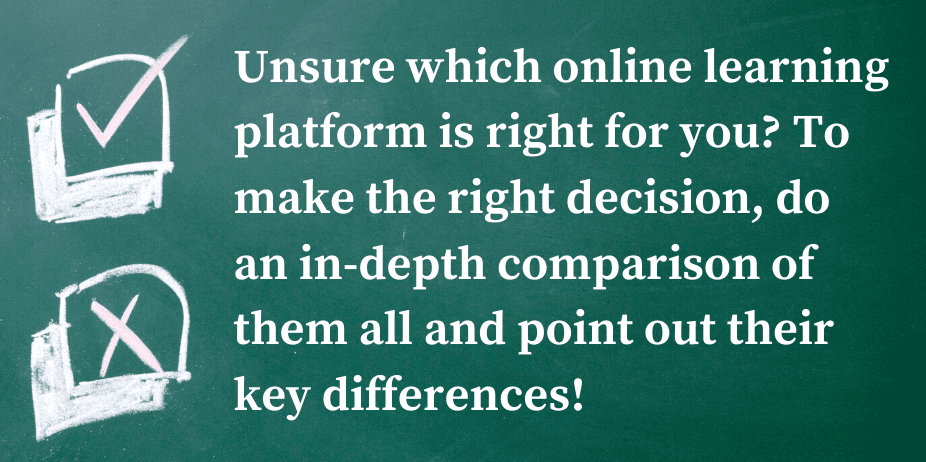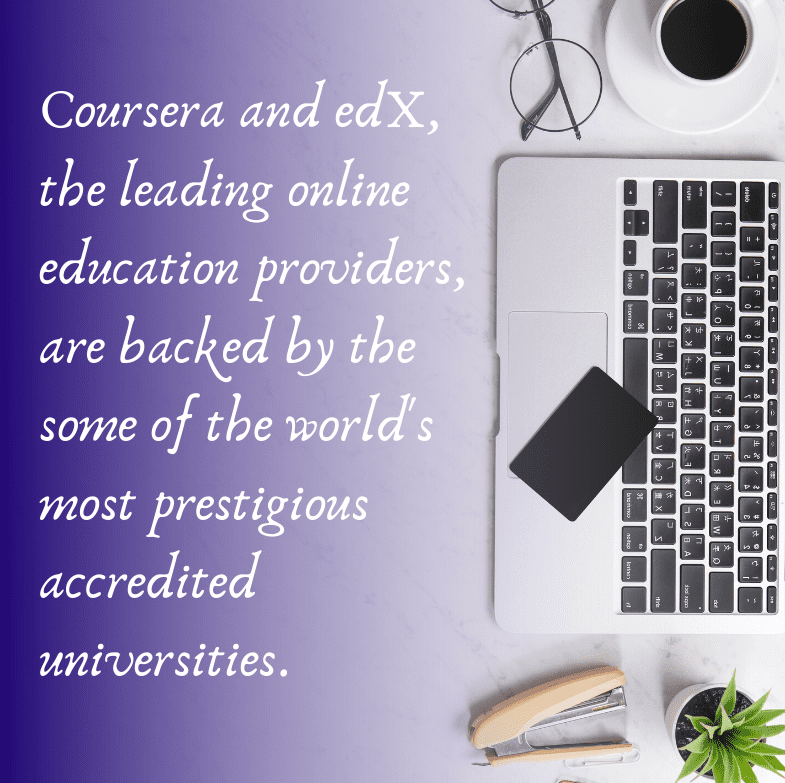
The demand for online learning in higher education has gained momentum in recent years. Students who are looking for convenience, accessibility, flexibility, and low-cost schooling are considering remote alternatives to conventional learning.

The global online education market is soaring new heights and projected to hit $325 billion by 2025. In the U.S., there were around 6.6 million students who took at least one distance education subject in 2017. The number of online learners has reached a new peak at more than 3.1 million. Some 79% of Americans found web-based learning platforms to “better than” or “equal to” the traditional face-to-face education.

The wide variety of e-learning offers a good deal of free subjects and course lengths ranging from academic-centered fields like Business Management to the Arts, Science & Technology, and Law to life-skill learning such as creative writing and practical communication courses. The majority of online college courses offer users the option to obtain certificates and credits and unlock additional course materials.
As a virtual student, you should consider your personal and professional commitments before choosing the right online courses. Be sure to fulfill class scheduling requirements. Not only that, see to it that you are attending legitimate online programs to help you upskill or reskill.
When choosing an online course that perfectly suits your academic goal, do your research! To assist you in finding top-quality, legitimate virtual learning platforms, we compiled the best ten sites for free college courses online:

Coursera
edX
Udemy
ALISON
Skillshare
LinkedIn Learning
FutureLearn
Udacity
OpenLearn
Class Central
Coursera
Users: 47 million (Dec 2019)
Affiliations: The Pennsylvania State University, Yale University, Princeton University, Stanford University, Imperial College London, Yonsei University, Johns Hopkins University, and more
Courses available: 3, 900+
Available in: English, Hindi, Spanish. Arabic, French, Russian, Portuguese, Turk, Ukrainian, Hebrew, German, Italian
Pros
- Expertly curated classes from well-respected universities
- A wide selection of credible courses
- Helpful community forum
- User-friendly interface
Cons
- Typically more expensive compared to other sites
- Courses not as flexible which needs a level of required commitment
More About Coursera
Arguably the most popular in the professional course marketplace, Coursera is affiliated with more than 190+ leading universities and organizations across 29 countries. Established in 2012, Universities of Princeton, Michigan, Pennsylvania, and Stanford were the first to offer their online content. Aside from reputable partners outside the U.S. such as the Indian School of Business, Korea’s Yonsei University, and Imperial College, established companies like Google and IBM share their knowledge in related fields like machine learning and I.T. automation.
In one searchable database, it brings a wide range of in-depth subjects and perspectives with more than 3900+ courses and specialization, 13+ professional certificates, and 20+ degrees & MasterTrack™ Certificates. Geared toward their mission of “world-class learning for anyone, anywhere,” professional development learners have eighty-seven percent reported career benefits based on their 2019 site survey.
The platform features recorded lectures of top professors from well-respected universities. The syllabus also includes community discussion forums, and both peer-reviewed and auto-graded assignments are available. Another clear advantage of Coursera is the easy navigation within their site as the course syllabus is easily accessible. Students can download their app for self-paced mobile learning.
While it is free to join these online classes, students should log first to view the pricing information on every course. It also has three types of course classifications with monthly to yearly subscription fees. These are categorized into main courses that have 4-6 weeks standard duration, specialization courses that have hands-on coursework, and; online degree program for acquiring a bachelor’s or master’s degree that takes one to two years to finish.

edX
Users: 20 million (September 2019)
Affiliations: Massachusetts Institute of Technology, Harvard University, Berkeley University of California, and more
Courses available: 2, 500+
Available in: Arabic, Catalan, Chinese, English, French, Hebrew, Indonesian, Korean, Polish, Portuguese, Russian, Spanish, Thai, Ukrainian
Pros
- Great resources for science and programming students
- Good user interface
- Integrates research-learning methods
- ‘Blended Classroom’ Engagement
Cons
- Lesser international affiliations
- Less informative community forums
More About edX
Another prominent leader in the massive open online course (MOOC), edX has more than 20 million users in its platform. This non-profit organization was founded in 2012 by the prestigious Harvard University and Massachusetts Institute of Technology (MIT). Aside from these top U.S. academe, it includes respected universities around the world and company leaders in the industry like Boston University, Berkeley University of California, Caltech, and International Monetary Fund.
Having an open-source philosophy, it currently offers more than 2,500 courses in its site. With top universities mentioned in their brand, the classes are worth learning despite not having many colleges compared to Coursera. Being founded by MIT and Harvard, edX’ courses emphasize science and programming with superb resources for students. Additionally, it utilizes research into their distance learning and even edX member schools. It is also engaged in ‘blended classrooms’ from different educational institutions around the world where traditional classes include a virtual interactive component.
While most other online platforms offer general education courses, edX has five different course types. These are edX Verified courses that award Certificates of Completion, xSeries Programs led by top-tier universities, High School Courses, Credit Eligible Courses, and Professional Development courses as their names imply. Finally, with its excellent and clean user interface, students can focus on the course topics and learn more.
In this platform, the certificates are free or can cost between $50-300 per course. Compared to Coursera, community discussion forums are not as worth-reading and informative. Since courses are dominated by science and programming, edX can introduce more subjects in other academic disciplines. Even if they have some of the recognized American universities and industries, international academic affiliations also need to be roped in for more diverse content and knowledge.

Udemy
Users: 50 million (January 2020)
Affiliations: Internal
Courses available: 150, 000+
Available in: English, French, Spanish, Portuguese, German and Chinese
Pros
- A massive number of courses
- Lifetime access to enrolled courses
- Ability to ‘test drive’ for paid courses
Cons
- Minimal academic credit and certificate of completions
- Overlapping course content
- “Hit or miss” instructor expertise
More About Udemy
Aimed at professional adults and students, well-established provider Udemy has a large user base. To make education more accessible and improving lives through learning, this 10-year old e-learning site has 295 million course enrollments in 65+ languages and 33 million minutes of video. Moreover, this American-based site has two-thirds of its 50 million students outside the country.
Udemy’s extensive search engine tool has courses in 15 major categories with 15+ subcategories under each main category. It stands out for the quantity and rating system of their programs. Upon enrollment, online students will have unlimited access to preferred courses with all the downloaded course materials. This lifetime access allows them to master the subject despite their other personal commitments if they get left behind. While there exist discounts and low-cost courses, students can have a free preview of one lesson with a guaranteed 30-day money return.
While one-third of their courses are free, Udemy offers little in academic credit and employer-recognized certificate of completions. It is more about teaching you skills than building your resume. The plethora of courses also overlaps with other similar classes making student’s selection difficult in finding what best fits for them. With 57 thousand instructors that rely on open market strategies, their “anyone can be an instructor” approach can pose a question on course creator’s expertise and experience.

ALISON
Users: 15 million
Affiliations: Third-party E-Learning Sites
Courses available: 1,500+
Available in: English, Spanish, French, Portuguese, Russian, Arabic, Chinese, Hindi, Urdu and more
Pros
- Generally free classes
- Centered on job-applicable skills
- Interactive learning experience
Cons
- Non-accredited courses
- No course descriptions
- Not optimized of app-dedicated learning
More About ALISON
An Ireland-established site in 2007, Advance Learning Interactive System Online (ALISON), is popular in around 195 countries. This “for-profit social enterprise” is one of the leading certifiers in educational and skill attainment with 2.5 million graduates.
Compared to Udemy that they create their courses, Alison is more of a platform and course marketplace. With this, it works by gathering available free courses all over the web. It currently offers these courses in nine distinct categories, where most of them focus on workplace-based skills. Users can also opt for trending, most popular or recent courses in their database. Their self-paced designed certificate, diploma, and learning path courses can be learned within 2-3 hours, 8-10 hours, and 18-20 hours respectively. For a paid service, it provides a digital/ hard copy of certifications. This e-learning platform has a clean and easy-to-use interface that provides an enriching and interactive online education experience.
Though Alison courses are generally recognized by many employers, one of its main drawbacks is they are not accredited by any external body. The lack of course descriptions is another downside since students are interested to know the subject first-hand briefly. Furthermore, this web-based learning system is not yet optimized for mobile applications. Some of their courses are also not in video format, making it a “hit or miss” in learning the content.

Skillshare
Users: 9 million
Affiliations: Internal
Courses available: 26, 000+
Available in: English only
Pros
- Designed for creative education
- High-quality courses
- Interaction-centered education
- Free trial access for course database
Cons
- Does not provide certificates
- No accreditation
- Only offers e-mail support
More About Skillshare
Having one of the largest libraries of virtual classes, Skillshare is considered the “Netflix for education.” This American online learning community was founded in November 2010 with four main course categories: Creative, Business, Technology, and Lifestyle taught by industry experts. Their philosophy is not only concentrated on student members, but also to teachers and employees that has $5 million earning in total.
In their mission statement to “explore your creativity,” Skillshare is designed to provide an avenue for creative thinkers to unlock their skills and talent in their respective fields. All online classes are self-paced, from graphic design and content marketing to web development and fine arts. Even though anyone can theoretically teach in this e-learning site, it ensures that teachers are qualified for such courses as each profile has an average trust rating and reputation remarks.
SkillShare’s educational approach also focuses on interaction rather than simultaneous studying. This is through Engagement Tools like Workshops and Groups intending to learn through project completion. While new users can get one-month free trial access to the entire course catalog, an option for a paid Skillshare Premium account is offered on a monthly and annual basis.
One downside of the course has no available free printable certificate. While there are notable courses that Skillshare is offering, it has no affiliated accreditation in professional industries. Even though that this New York-based site has useful support articles, the single way to contact them is only through e-mail despite the rise of customer care hotlines.

LinkedIn Learning
(formerly Lynda.com)
Users: 17 million
Affiliations: Microsoft, Google, Autodesk and more
Courses available: 15,000+
Available in: English, French, Italian, Spanish, Portuguese, Tagalog and more
Pros
- Concentrates on corporate learning
- Access to a social network of professionals
- Shareable Certificates to LinkedIn Account
Con
- New and lesser-known courses
More About LinkedIn Learning
LinkedIn Learning has become a well-liked online course marketplace in the corporate world. With the acquisition of Lynda.com in 2015, it emphasizes its course categories on Business, Creative, and Technology. A subsidiary of LinkedIn and owned by Microsoft, its reputation has been trusted by business-related sectors.
This e-learning site is primarily tailored for business professionals seeking to update their skills. It covers hundreds of business topics from corporate finance, project management, career development, and more with highlights on trending and popular courses. The format of LinkedIn Learning’s content is easy to digest. Students can take multiple courses that engage in video and written content without entirely committed to only one program. Additionally, your access to prospects of hiring managers and employers can have higher chances since it is under the flagship of the world’s largest professional network LinkedIn. While initially free for a one month trial with no upfront costs, certificates of completion can be posted directly on your LinkedIn Profile for 690+ million users to view in 200+ countries across the globe.
Students need to put a considerable effort into researching the quality of courses that best fit them, especially for new and lesser-known ones. This is due to the endless number of courses on the same subject and discipline. Even if LinkedIn Learning emphasizes technical training and soft skills, it would be better to have more intermediate and advanced courses. Since most topics center on business, it seemingly lacks on industry-related content that on insurance companies and integration with H.R. systems for tracking of learning objectives compliance.

FutureLearn
Users: 10 million
Affiliations: the University of Bristol, King’s College of London, University of Exeter, Middlesex University Business School, The Pennsylvania State University, UNESCO, and more
Courses available: 210+
Available in: English, French, Dutch, Spanish, Chinese and more
Pros
- Quality of courses offered
- Well-built syllabuses
- Excellent peer-to-peer discussions
- User-friendly interface and easy navigation
Con
- No Android and iOS apps available
More About FutureLearn
A part of The Open University, FutureLearn is a UK-based online education provider. It was launched on the rise of MOOC competition to place British online courses on the world map. With their purpose to transform access to education, it was the first online education site to give students degree credits from a top U.K. university, according to Financial Times. Founded in December 2012 with twelve U.K. university partners, it is currently affiliated with 175 global institutional partners.
Britain’s digital education platform hosts a selection of quality courses. These come from world-leading academic institutions, specialist organizations, and centers of excellence universities with an archive of cultural, historical, and educational materials. Once online learners start a course, they have fourteen-day access to this. The curriculum is dissected into bite-sized lessons for students to digest each concept and ideas readily. FutureLearn also emphasizes peer-to-peer knowledge engagement and creating a sense of community amongst students for a more enjoyable and social experience in learning. Moreover, its straightforward user navigability can get students back on track for missed lectures.
One element that makes the Future Learn a disadvantage is the lack of an app-dedicated smartphone. As online courses are geared toward flexibility and accessibility, learning can also take place outside the home. A smartphone-built app seems more user-friendly compared to a website in the mobile device. This will also enable more virtual freedom to students in resuming other tasks. Finally, even if there are limited 210+ courses currently available in Future Learn, it is still relatively small compared to other MOOCs. In the future, we hope the site can add more course catalog to cater diversity of students and edge up their competition.

Udacity
Users: 11.5 million
Affiliations: Accenture, Amazon, Google, Facebook, Shell, Twitter and more
Courses available: 300+
Available in: English and Chinese only
Pros
- Programmed for tech students
- Has an app based-learning
- Video-based interactive platform
- Paid Nanodegree options
- Offers career support
Con
- Rigorous courses
More About Udacity
Founded by Stanford instructors in June 2011, Udacity is a for-profit educational organization that is a leader in cutting edge programs for future tech students. Instead of affiliating with Universities, they focused on large enterprise and curriculum partners such as Amazon, AT&T, Google, Shell, Mercedez-Benz, and even the social networking sites Facebook and Twitter.
With more than 200 IT-related industries on their page, Udacity’s in-depth curriculum is centered on this field. Among the popular technical courses are Web Development, Artificial Intelligence, and “Self-driving Car” that are presently in demand in the business market.
Udacity has a dedicated smartphone app with offline mode features, enhancing user flexibility and accessibility. Aside from the site’s vast selection of free courses, the paid Nanodegree Programs is also one of its best features. Udacity courses boost industry credentials and link users to job-relevant programs and hiring partners.
The majority of Udacity courses are complex and pose challenges. These challenges are as in-depth as a University degree information in a short period. As a student, you should also consider doing extensive outside research as it requires advance study preparation. Improvement in the student-mentor relationship can also be suggested for prompt communication from online professors.

OpenLearn
Users: 9 million a year
Affiliations: British Broadcasting Corporation (BBC), University Alliance, Association of Commonwealth Universities, Middle States Association of Colleges and Schools, and more
Courses available: 1,000+
Available in: English
Pros
- Free academic-led contents
- Immediately available courses
Cons
- Questionable contents
- Non-user friendly interface
More About OpenLearn
Offering content from The Open University (O.U.), OpenLearn was initially designed to be an educational website in the ’90s for free access to learning materials. With their vision of reaching to millions of learners every year, it attracted almost 75 million visitors since its conception. These from users on over 230 countries where their free courses are being adapted in O.U. modules and affiliated associations in Britain and America. Their longest-standing partnership with BBC has co-funded both from in-house and independent suppliers.
OpenLearn covers a wide range of subjects and contents. With 1000+ of short courses in specific areas of learning, they are divided into three levels: introductory, intermediate, and advanced. Their free learning resources include thousands of articles, quizzes, interactive games, videos, audios, and BBC-produced booklets. Unlike some sites that have start and end dates, a student can start a course in OpenLearn right away. While some courses may take more time, you may slow down for a while, track your progress, and work in earning a digital badge or Statement of Participation after completion. Their free certification is entirely dependent on third-party course providers.
Each course requires anywhere between one and 100 hours of study. Some are brief, such as video lessons that take only five minutes to finish, which raises issues on free content quality. Another disadvantage is navigating through the free courses as it is only a list view without options for course description, type, or duration. Hence, you have to spend a lot of time clicking in the master list for every course title, then wait for course details to load and back again to the course list in one tedious cycle.

Class Central
Users: 1.5 million
Affiliations: Third-party E-Learning Sites
Courses available: 15, 000
Available in: English, French, German, Arabic, Russian, Japanese and more
Pros
- User-friendly platform
- Large library of courses
- Well-known content providers
- Highest-rated online course recommendations
Con:
- Search engine site than an educational provider
More About Class Central
A remote company with no physical office, Class Central originated in 2011 that caters to free online courses. The site aggregates courses from both American and international academic institutions, including web learning sites like Coursera, FutureLearn, and edX.
Like Alison, instead of creating the courses and classes themselves, Class Central is a curator of course contents. With more than one MOOC provider, the search can practically cover all existing courses on the internet. Through the site’s browsing filter, it finds the one that suits you best, especially filtering free courses only. There are also reviews from previous students as well as a detailed course description. If you are up for one of Ivy League Schools, this user-friendly site has a specific filter for that. Not only can students get personalized recommendations but also track subjects they find as a valuable academic prospect. Finally, Class Central also provides rankings of its best courses annually for better user insight.
More than a producer of educational classes, Class Central only works as a listing of online courses. With that being said, a student may overwhelm with everything on the list and are free by taking multiple courses without having a full-time commitment.
Now that online education is instantly accessible in a few clicks, grab the cost-free opportunities to achieve your personal, academic, or professional academic. Whether you’re aiming to master a new skill or choose to advance in your career, take advantage of free, portable, and convenient learning options. There are no limitations to what you can learn online!
